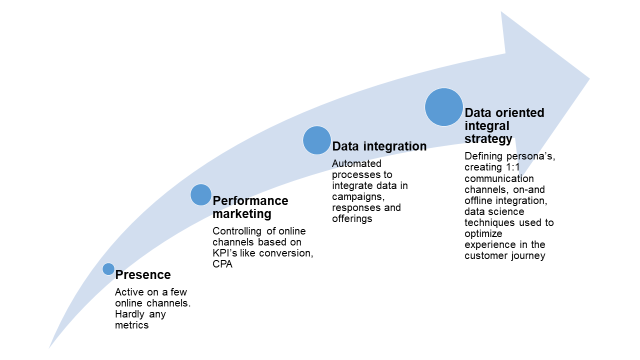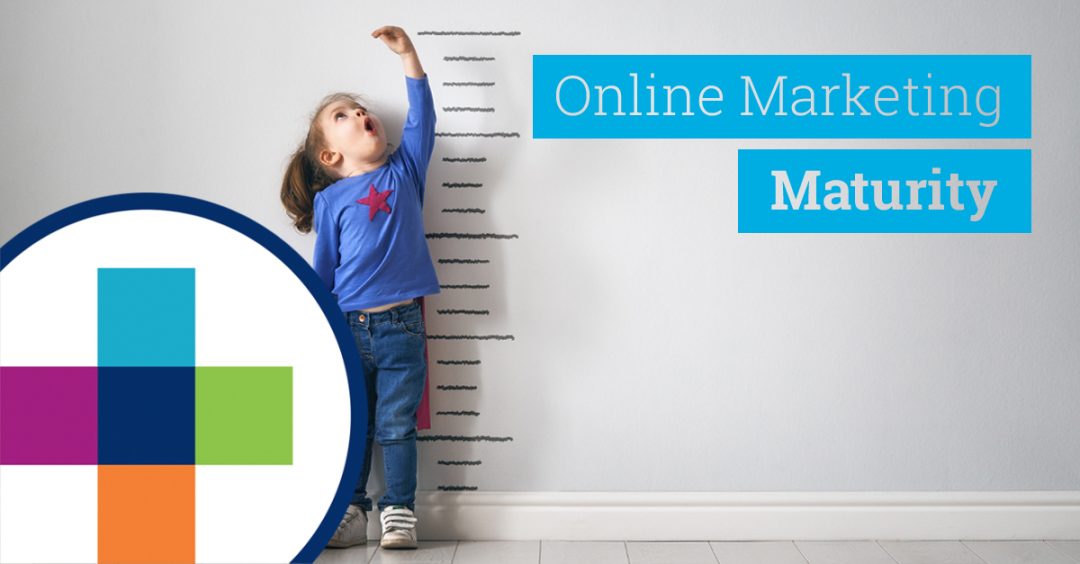Online Marketing Maturity – How Prediction Models Lead to Growth in Marketing Maturity
The future of retail is created by consumers. They are more critical and better informed than ever before, while looking for more convenience and more value, as well as excitement, meaning, status, relevance, authenticity, and more. Meanwhile, the future key players in this market are the brands and companies that respond effectively to these expectations by connecting creativity with technology in optimizing the end-to-end customer experience.
The Online Marketing Maturity Scan – a tool introduced by the Online Marketing Maturity Expert Group of ShoppingTomorrow – can be used as a guide as to how to respond to these emerging customer expectations. The scan considers how organizations are in different phases of maturity, and how to subsequently grow to get to the next phase. In order of maturity, the phases are: presence, performance marketing, data integration, and data oriented integral strategy. The latter is the phase in which data-science techniques can be used to create prediction models which can lead to optimized customer experiences in the customer journey.

[ShoppingTomorrow – Blue paper Online Marketing Maturity]
Meaning and importance of customer experience
There are multiple definitions for customer experience. The major accepted definition is that it concerns the experience of a (prospective) customer – in terms of cognitive, emotional, behavioral, sensorial, and social responses – based upon touch points with an organization during the customer’s entire purchase journey. Within this journey, there are several touch points which jointly add up to the customer experience.
Customer experience is key to the success of an organization. It helps organizations to stand out from the competition, and it gives the edge in today’s world where the customer is demanding and critical. The customer experience is central to the concept of the Customer Lifetime Value (CLV), which is a valuable metric to measure the success of an organization.
Transforming the customer experience
To improve the customer experience, organizations must create and deliver the right touch points to the customer, focusing on the experience within the various phases of the customer journey. Therefore, every touch point should be critically assessed, questioning whether it contributes to a better customer experience. Besides this, organizations which are in the most mature phase of online marketing can implement data-driven prediction models to optimize the customer experience. Examples of such prediction models are recommender systems, chatbots, and dynamic pricing.
Prediction models transforming the customer experience
Recommender
Have you ever wondered how Netflix knows what kind of movies or series you might be interested in watching? Or how Facebook knows who to suggest as “people you might know”? These kinds of examples are the result of a recommender system: a tool to gather user information, analyze it, and transform it into an engaging, personalized user experience for the customer. A specific case where we have used this model was at one of our international event clients who was looking to help their customers find what they are interested in at events more easily. The recommender system uses historic and real-time information to internalize customer interests, translating this data into personalized recommendations for the most interesting stands to visit. Meanwhile, the company can use the recommendations as content for e-mails, apps and on their website.
Besides the ability of a recommender system to predict interesting alternative products for a customer, also additional products can be predicted, such as recommended additional items which fit with the initial search query of a customer. These are called Frequently Bought Together’s (FBT’s), creating cross-sell opportunities.
Chatbot
Today’s customer service needs to be faster than ever: besides the quality of the service, speed has become more critical for the customer. To realize this, a chatbot – a virtual aid for arranging customer service through a live chat interface – can be a useful tool for providing instant and accurate answers. Based on keywords, chatbots are capable to directly answer search- and knowledge questions in a personalized way. Meanwhile, customers receive the same level of service they receive from a support representative since chatbots can recognize human emotions such as joy, anger, and confusion. We applied a chatbot for a health insurance company. The call center employees of the company embracing this technology, combined with the significantly improved customer experience and internal efficiency improvement, makes the chatbot a valuable tool in their customer journey.
Pricing
For big retailers, optimal pricing is key to keep a competitive advantage, whereas for the customer, pricing is a touch point: it is a place where the customer’s emotions and decisions interact with the organization’s offering. Pricing in the context of the customer experience is much more than the actual price on the price tag: it also involves all situations that result from a company’s pricing decision. Have you ever squeezed into a middle airplane seat because changing it would mean choosing a preferred seat, and is therefore pricier? This is a typical example of the effect of pricing on the customer’s experience. By improving the price experience, the customer experience can be improved. For companies to address this challenge, it’s important to understand what drives the customers’ price perception. Through dynamic pricing, companies can create and constantly update their pricing strategy in an optimal way: retaining a competitive advantage without comprising on margin levels.
Responding effectively to the expectations of today’s customers can be achieved through optimizing the customer experience. Besides reviewing existing touch points, various data-driven prediction models such as recommender systems, chatbots, and dynamic pricing systems, can be implemented which can all positively contribute to an improved experience in their own way. Nevertheless, to reach the phase of a data-oriented integral strategy, businesses need to know at which phase they currently are, and how to grow. To get to know more about the different online marketing maturity phases, you will find the link to the scan and read more about it in our news item.
The highlights of the blue paper – reposted by CustomerTalk (Dutch link)
The post Online Marketing Maturity – How Prediction Models Lead to Growth in Marketing Maturity appeared first on This Complex World.
Leave a Comment
You must be logged in to post a comment.








